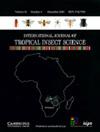氧化锌纳米颗粒对北方库蚊(库蚊科)幼虫的慢性作用
IF 1.2
4区 农林科学
Q3 ENTOMOLOGY
International Journal of Tropical Insect Science
Pub Date : 2023-10-10
DOI:10.1007/s42690-023-01092-6
引用次数: 0
摘要
据估计,每年有多达一百万人死于蚊媒疾病。为避免蚊媒疾病的流行,有必要减少蚊虫的数量。对蚊子进行有效管理的挑战主要与杀虫剂抗药性的出现有关,从而增加了开发替代方法的需要。理想的杀虫剂要对目标昆虫产生持久的作用,以确保有强大的杀虫效果。本研究假设氧化锌纳米颗粒(ZnONPs)对林奈库蚊(1758)幼虫的影响是不可逆的、慢性的。以亚致死浓度(lc20, 0.24 g/L)的ZnONPs处理1龄库蚊幼虫72 h后,恢复72 h,记录恢复幼虫与未处理幼虫锌积累、生长速率、肠道超微结构、过氧化氢、抗氧化和解毒酶的生化变化,并进行比较。与未处理的对照相比,恢复后的幼虫体内锌含量显著增加,生长速率降低约50%。此外,在恢复后的幼虫中肠不同部位,消化道上皮的超微结构表现出多种形式的病理征象。ZnONPs处理诱导氧化应激,表现为过氧化氢浓度显著升高。作为对OS的反应,昆虫会激活解毒系统来清除有毒的纳米颗粒。对ZnONPs的毒性作用抑制了解毒酶碱性磷酸酶(ALP)和谷胱甘肽过氧化物酶(GPX),激活了超氧化物歧化酶(SOD)。此外,恢复的幼虫过氧化氢酶活性与未处理的对照没有差异。这些结果验证了ZnONPs对淡纹库蚊幼虫的慢性影响,表明ZnONPs可以通过在积雨和游泳池等静水源中直接施用来管理淡纹库蚊幼虫。本文章由计算机程序翻译,如有差异,请以英文原文为准。
Chronic effects induced by zinc oxide nanoparticles against larvae of the northern house mosquito Culex pipiens (Diptera: Culicidae)
Abstract It is estimated that up to a million person are subject to death every year from mosquito-borne diseases. To avoid the epidemic situations arising from mosquito-borne diseases, it is necessary to reduce the mosquito populations. Challenges against efficient mosquito management are mainly related to emergence of insecticide resistance leading to increased need for the development of alternative methods. Ideal insecticides cause permanent impacts on the target insects in order to ensure powerful insecticidal effect. This study hypothesized that the impact of zinc oxide nanoparticles (ZnONPs) on the larvae of Culex pipiens Linnaeus, 1758 (Diptera: Culicidae) mosquito is irreversible and chronic. The first instar C. pipiens larvae were treated with a sublethal concentration (LC 20 , 0.24 g/L) of ZnONPs for 72 h and then allowed to recover for additional 72 h. Following the recovery period, the changes in zinc accumulation, growth rate, gut ultrastructure, biochemical changes in the hydrogen peroxide, antioxidant and detoxification enzymes were recorded and compared between recovered larvae and untreated (control). Recovered larvae showed significant increase in the accumulated zinc and reduced growth rate by about 50% compared to untreated (control). Furthermore, the ultrastructure of the alimentary canal epithelium showed several forms of pathological signs in different parts of the midgut of recovered larvae. Treatment with ZnONPs induced oxidative stress (OS) which appeared in the form of significant increase in hydrogen peroxide concentration. In response to OS, insects activate the detoxification system to get rid of the toxic nanoparticles. The detoxification enzyme alkaline phosphatase (ALP) and the antioxidant enzyme glutathione peroxidase (GPX) were inhibited while superoxide dismutase (SOD) was activated against ZnONPs toxicity. Additionally, recovered larvae didn’t show differences in the catalase activity from untreated control. These results verified that ZnONPs induce chronic impacts on C. pipiens larvae suggesting that it can be used in their management via direct application in standing water sources including accumulated rains and swimming pools.
求助全文
通过发布文献求助,成功后即可免费获取论文全文。
去求助
来源期刊

International Journal of Tropical Insect Science
ENTOMOLOGY-
CiteScore
2.40
自引率
8.30%
发文量
212
期刊介绍:
International Journal of Tropical Insect Science is the only journal devoted exclusively to the latest research in tropical and sub-tropical insect science. Each issue brings you original, peer-reviewed research findings on tropical insects and related arthropods, with special emphasis on their environmentally benign and sustainable management.
The Journal"s scope includes arthropod ecology and biodiversity, ethno-entomology, arthropod taxonomy, integrated pest and vector management, and environmental issues. The Journal publishes research papers, short communications and scientific notes. The Journal also includes reports of meetings and obituaries of prominent scientists, book reviews, and review and mini-review articles that are normally submitted at the invitation of the Editors.
 求助内容:
求助内容: 应助结果提醒方式:
应助结果提醒方式:


